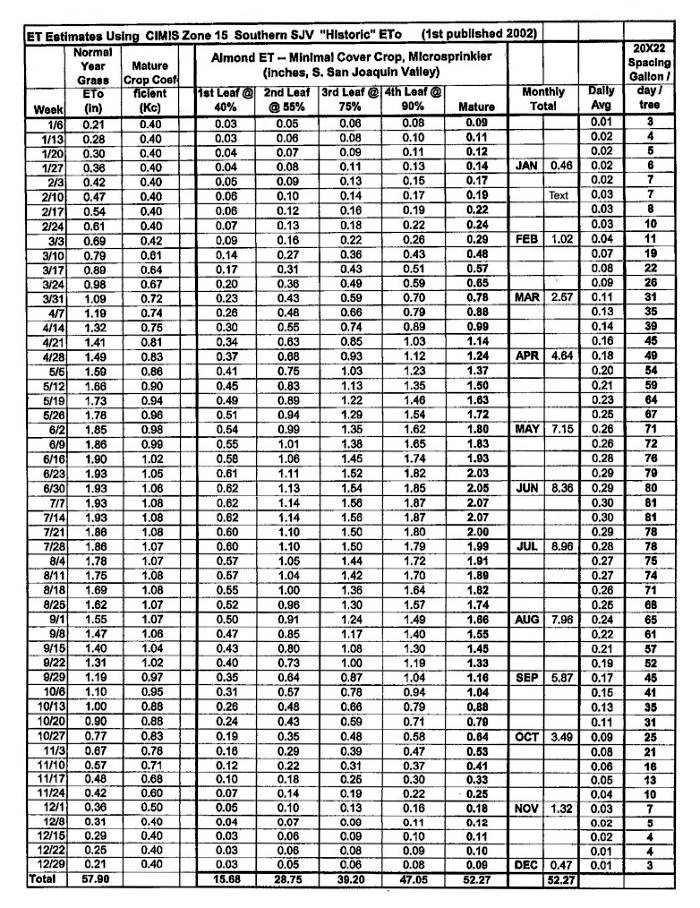Almond trees are one of the most valuable permanent crops in California, producing about 80% of the world’s almonds. However, they also require a lot of water, especially during the fruit development stage. Therefore, almond irrigation management is extremely critical.
In this blog post you will find tips on how to:
- Optimize irrigation practices to ensure exceptional yields
- Improve almond crop quality
- Possible irrigation water savings (deficit irrigation strategy)
Almond Tree Water Requirements
Before we can effectively manage almond irrigations, we need to know how much water our trees need. The water requirement of almond trees depends on several factors, such as location, climate, soil type, tree age, canopy size and crop load. The most common way to estimate the water requirement is to use the reference evapotranspiration (ETo) and a crop coefficient (Kc) that reflects the tree’s water use relative to a reference crop (usually grass).
Below is Evapotranspiration chart for almonds in Southern San Joaquin Valley in California. Here you can also download a PDF version of this ET chart.
Sensitivity to Water Stress
Water stress occurs when the tree’s water demand exceeds its water supply. Therefore, resulting in reduced soil water availability, increased tree water deficits and decreased transpiration. Water stress can affect vegetative growth, fruit set, nut size, hull split, kernel quality and yield.
However, not all stages of almond growth are equally sensitive to water stress. Some stages are more critical than others and require more careful irrigation management to avoid negative impacts.
Most Sensitive Water Stress Stage for Almonds
According to recent research, the most sensitive water stress stages for almond are:
- Early season: from budbreak through fruit set (March-April). This is when rapid vegetative growth occurs, which is essential for canopy development and fruiting development for the next season. Water stress during this period can reduce shoot growth, leaf area, photosynthesis, and carbohydrate reserves. It can also reduce fruit set by affecting flower quality, pollination, and fertilization.
- Rapid fruit growth: from late May to early June. This is when nuts undergo a rapid increase in size and weight. Water stress during this period can reduce nut size and yield potential.
- Postharvest: from mid-August to mid-September. This is when bud differentiation occurs for the next season’s crop. Water stress during this period can reduce bud formation and fruit set for the following year.
The Least Sensitive Stage
- Almond Preharvest: from late June to hull split (July-August). This is when nuts reach their final size and weight, and hulls start to split open. Water stress during this period has a negligible effect on kernel weight or quality. It can also reduce hull rot incidence by limiting fungal growth. However, severe water stress just before hull splitting can reduce hull splitting and increase the number of hull-tights.
Optimized Almond Irrigation Mangement Possible Water Savings
Because of different water stress sensitivity stages, growers can implement deficit almond irrigation management strategies that aim to reduce water use while minimizing yield losses. Deficit irrigation involves applying less than the full ETc during certain periods of the season.
Almond Preharvest – The Most Effective Deficit Irrigation Strategy
- Preharvest deficit irrigation: applying about 70% of ETc from late June to hull split. This strategy can save about 15% of seasonal water use without affecting kernel weight or quality. It can also improve hull split and reduce hull rot incidence by inducing moderate water stress before hull split. However, it is important to apply a preharvest irrigation of about two inches with sprinklers (less with Microjet or drip) to ensure good hull split and avoid severe water stress.
